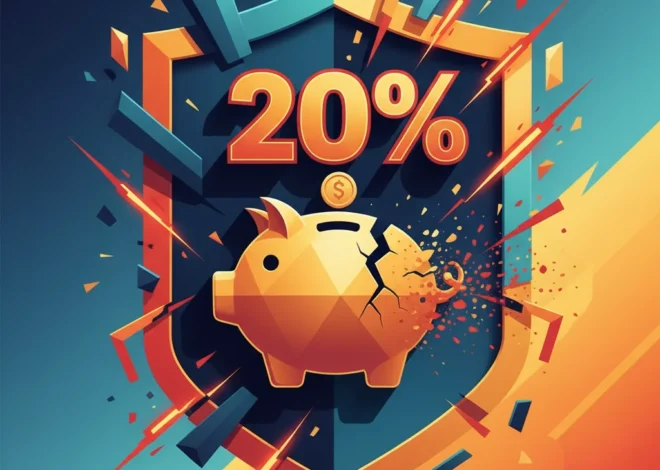
The Chicken Paprikash Portfolio: A Recipe for Chaos-Free Investing
In the world of finance, the prevailing narrative often glorifies chaos. We picture the frantic energy of a trading floor, the relentless volatility of the stock market, and the disruptive force of financial technology. Success, we are told, is forged in the crucible of high-stakes, high-speed decision-making. But what if the most effective strategy for long-term financial success isn’t a chaotic sprint, but a patient, methodical simmer?
Consider, for a moment, an unlikely source of wisdom: a recipe for Chicken Paprikash from the Financial Times. Described as a “chaos-free dinner crowd-pleaser,” this classic Hungarian dish offers a powerful blueprint for building a robust, resilient, and ultimately rewarding investment portfolio. Its preparation eschews complex techniques and last-minute panic in favor of quality ingredients, a proven process, and the transformative power of time. By deconstructing this recipe, we can uncover timeless principles applicable to navigating the modern economy, from personal finance to institutional investing.
This isn’t just about cooking; it’s about adopting a culinary philosophy for capital growth. Let’s trade the stock ticker for a stockpot and explore how the art of making Chicken Paprikash can inform a more deliberate and successful approach to wealth management.
Mise en Place: Assembling Your Core Financial Ingredients
Every great dish begins with “mise en place”—a French term for having all your ingredients measured, cut, and prepared before you start cooking. In the kitchen, this prevents chaos. In investing, it prevents costly mistakes. Your financial mise en place involves comprehensive due diligence and a clear understanding of the assets you intend to acquire. It’s about knowing what you own and why you own it.
This foundational stage requires a deep dive into the fundamentals. You wouldn’t use subpar ingredients and expect a gourmet meal; likewise, you cannot build a strong portfolio on speculative assets without understanding their intrinsic value. This means analyzing company balance sheets, understanding market trends, and assessing the broader economic landscape. According to a study by Charles Schwab, a disciplined approach to portfolio construction, which begins with this preparatory phase, is a critical determinant of long-term returns.
Your core ingredients might include:
- Blue-Chip Stocks: The high-quality chicken of your portfolio. These are shares in large, well-established, and financially sound companies with a history of reliable performance. Think of stalwarts in sectors like consumer staples, healthcare, or traditional banking.
- Bonds and Fixed Income: The onions, garlic, and broth. They form the aromatic, stabilizing base. While less glamorous than stocks, they provide stability, income, and a hedge against market volatility.
- Growth Assets: The paprika itself. These are the elements that add color, excitement, and the potential for significant returns. This could include stocks in emerging technology sectors or investments in high-growth economies.
- Alternative Investments: The enriching sour cream. Assets like real estate, commodities, or private equity can add depth and diversification, reducing correlation to the public stock market.
Just as a chef inspects each vegetable, a prudent investor scrutinizes each potential asset. This initial, unglamorous work is what separates a haphazard gamble from a well-structured investment strategy.
The Searing and Sautéing: Establishing a Resilient Base
The recipe for Chicken Paprikash begins by browning the chicken. This step is crucial; it builds a “fond” at the bottom of the pan—a layer of caramelized proteins that forms the deep, savory foundation of the entire dish. In portfolio terms, this is analogous to establishing your core holdings—the blue-chip stocks and foundational assets that will anchor your strategy through various market cycles.
These initial investments are not meant to be speculative, high-flyers. They are your bulwark against the inevitable volatility of the market. By “searing” in their value early, you create a base of stability that can support riskier, more growth-oriented assets later. Rushing this stage in cooking results in a bland sauce; in investing, it results in a portfolio that lacks a defensive backbone and is susceptible to panic-selling during downturns.
This phase is about a commitment to quality over hype. It involves identifying companies with strong economic moats, consistent cash flow, and proven leadership. This is the bedrock of your financial future, built not on fleeting trends but on enduring value.
The Paprika Principle: Strategic Diversification and Risk Allocation
Once the base is established, it’s time to add the star ingredient: paprika. A common mistake is to add it to a hot, dry pan, where it can easily burn and turn bitter. It must be incorporated carefully into the fat and onions, allowing its flavor to bloom. This is a perfect metaphor for adding risk and growth-oriented assets to a portfolio.
Throwing all your capital into the hottest new stock or a speculative fintech venture is like scorching the paprika. True diversification—the “Paprika Principle”—is about thoughtfully blending different asset classes to enhance returns without taking on unpalatable risk. Each “spice” in your portfolio should serve a purpose, complementing the others to create a balanced and complex flavor profile. The goal is a whole that is greater than the sum of its parts.
Below is a simplified comparison of culinary elements and their investment counterparts, illustrating the concept of a balanced portfolio.
| Culinary Element | Investment Analogy | Role in the Portfolio | Associated Keywords |
|---|---|---|---|
| Chicken (The Protein) | Blue-Chip Stocks & Large-Cap Equities | Provides the core substance and long-term growth potential. The foundational base of the portfolio. | Stock Market, Investing, Banking |
| Onions & Broth (The Base) | Bonds & Fixed-Income Securities | Creates stability, generates predictable income, and lowers overall volatility. | Economy, Finance, Economics |
| Paprika (The Spice) | Growth Stocks & Tech Sector | Adds the potential for high returns and capital appreciation, but requires careful handling (risk management). | Financial Technology, Fintech |
| Sour Cream (The Enrichment) | Alternative Investments (e.g., Real Estate, Blockchain Assets) | Offers diversification away from traditional markets and can enhance richness and returns. Added carefully at the end. | Blockchain, Trading |
This table demonstrates that a successful investment strategy isn’t about picking one “best” ingredient, but about understanding how different components work together to achieve a desired outcome.
The Simmer: Embracing Time and the Power of Compounding
The magic of Chicken Paprikash happens during the simmer. Over a low, steady heat, the flavors meld, the chicken becomes tender, and the sauce develops a profound depth. There is no way to rush this process. High heat will toughen the meat and ruin the sauce. This is perhaps the most direct and crucial lesson for any investor: the power of long-term compounding.
In the world of finance, the desire for instant gratification often leads investors to high-frequency trading, chasing short-term trends, and reacting emotionally to market news. This is the equivalent of cranking up the heat, a frantic activity that often leads to poor results. The “simmer” strategy involves buying quality assets and holding them for the long term, allowing your returns to generate their own returns.
Consider the historical performance of the stock market. Despite numerous crashes and recessions, the S&P 500 has delivered an average annual return of around 10% over the long run (source). This is the result of letting your investments simmer, weathering the occasional boil-overs and trusting the process. Patience is your greatest tool for building wealth, allowing the complex flavors of your diversified portfolio to mature and deepen over time.
The Finishing Touch: Rebalancing and Strategic Adjustments
Just before serving, the recipe calls for tempering sour cream and stirring it into the stew, adjusting the final seasoning. This is the portfolio rebalancing phase. Over time, due to market movements, your carefully constructed asset allocation will drift. The technology stocks (paprika) might have performed so well that they now represent an outsized portion of your portfolio, exposing you to more risk than you intended.
Rebalancing is the disciplined process of selling some of the assets that have grown and buying more of those that have lagged, returning your portfolio to its target allocation. It’s a counter-intuitive act—selling winners and buying losers—but it is fundamental to long-term risk management. It forces you to take profits systematically and prevents emotional decisions from dictating your strategy. This isn’t a frantic, daily activity. Like finishing a stew, it’s a periodic adjustment to ensure the final product is perfectly balanced and aligned with your goals.
Conclusion: Your Recipe for Financial Success
The parallels are clear: a successful investment journey, much like crafting a perfect Chicken Paprikash, is an exercise in discipline, patience, and adherence to a proven process. It begins with quality ingredients (diligent asset selection), relies on a solid foundation (core holdings), is enhanced by thoughtful additions (diversification), and reaches its full potential through the magic of time (compounding).
In an era dominated by the noise of 24/7 financial news, algorithmic trading, and the promise of instant riches, the “chaos-free” philosophy offers a powerful alternative. It suggests that building lasting wealth is not about frantic activity, but about thoughtful construction. By embracing the principles of a master chef—preparation, patience, and balance—any investor can create a portfolio that is not only profitable but also resilient enough to be a true crowd-pleaser for years to come.


